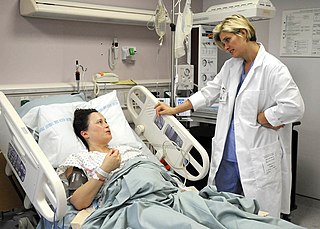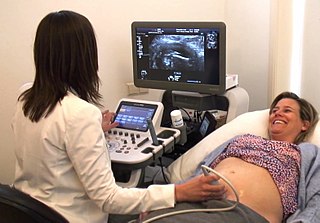Related Research Articles

The Nursing and Midwifery Council (NMC) is the regulator for nursing and midwifery professions in the UK. The NMC maintains a register of all nurses, midwives and specialist community public health nurses and nursing associates eligible to practise within the UK. It sets and reviews standards for their education, training and onduct epic super epic performances. The NMC also investigates allegations of impaired fitness to practise.

The Australian Nursing and Midwifery Federation (ANMF) is the largest union in Australia, with 274,956 members in 2018. The union is run by nurses, midwives and assistants in nursing to advance the industrial, political and professional interests of its members.

In the United States, a Certified Nurse-Midwife (CNM) is a nurse midwife who exceeds the International Confederation of Midwives' essential competencies for a midwife and is also an advanced practice registered nurse, having completed registered nursing and midwifery education leading to practice as a nurse midwife and credentialing as a Certified Nurse-Midwife. CNMs provide care of women across their lifespan, including pregnancy and the postpartum period, and well woman care and birth control. Certified Nurse-Midwives are recognized by the International Confederation of Midwives as a type of midwife in the U.S.
Nursing in the United Kingdom is the largest health care profession in the country. It has evolved from assisting doctors to encompass a variety of professional roles. Over 700,000 nurses practice, working in settings such as hospitals, health centres, nursing homes, hospices, communities, military, prisons, and academia. Most are employed by the National Health Service (NHS).

The Frontier Nursing Service (FNS) provides healthcare services to rural, underserved populations since 1925, and educates nurse-midwives since 1939.

Nursing in Australia is a healthcare profession. Nurses and midwives form the majority (54%) of Australian health care professionals. Nurses are either registered or enrolled. Registered nurses have broader and deeper education than enrolled nurses. Nurse practitioners complete a yet higher qualification. Nurses are not limited to working in hospitals, instead working in a variety of settings. Australian nurses are in demand as traveling nurses, particularly those with advanced qualifications.

Indian Nursing Council is a national regulatory body for nurses and nurse education in India. It is an autonomous body under the Government of India, Ministry of Health & Family Welfare, constituted by the Central Government under section 3(1) of the Indian Nursing Council Act, 1947 of Indian parliament. According to the original act the function of the council is to provide "uniformity in nursing education".
Dr Rhodanthe Grace Lipsett OAM was an Australian midwife and author. Throughout her professional life she specialised in infant and maternal health.
Nursing is a regulated profession in the Republic of Ireland. The Nursing and Midwifery Board of Ireland (NMBI) is the statutory regulator responsible for regulating both nursing and midwifery.
Ruth Watson Lubic, CNM, EdD, FAAN, FACNM, is an American nurse-midwife and applied anthropologist who pioneered the role of nurse-midwives as primary care providers for women, particularly in maternity care. Lubic is considered to be one of the leaders of the nurse-midwifery movement in the United States.
In the United States, certified nurse midwives (CNMs) are advanced practice registered nurses in nurse midwifery, the nursing care of women during pregnancy and the postpartum period. CNMs are considered as midwives.
Midwives in the United States assist childbearing women during pregnancy, labor and birth, and the postpartum period. Some midwives also provide primary care for women including well-woman exams, health promotion, and disease prevention, family planning options, and care for common gynecological concerns. Before the turn of the 20th century, traditional midwives were informally trained and helped deliver almost all births. Today, midwives are professionals who must undergo formal training. Midwives in the United States formed the Midwifery Education, Regulation, and Association task force to establish a framework for midwifery.

A midwife is a health professional who cares for mothers and newborns around childbirth, a specialisation known as midwifery.

A nurse midwife is both a nurse and a midwife, having completed nursing and midwifery education leading to practice as a nurse midwife and sometimes credentialed in the specialty. Nurse midwives provide care of women across the lifespan, including during pregnancy and the postpartum period, and well woman care and birth control.
Eunice Katherine Macdonald "Kitty" Ernst was an American nurse midwife and leader in the nurse-midwife movement in the United States.
Midwives in South Africa are nurses who focus on the care of pregnant women and the delivery of babies. Midwives have the ability to work independently in cases of healthy pregnancies and problem-free deliveries; however, they can refer patients to gynaecologists or obstetricians when complications are diagnosed. The majority of pregnant women in South Africa use the public healthcare system, and most of this care is provided by midwives.
The Congress of Aboriginal and Torres Strait Islander Nurses and Midwives (CATSINaM) is the peak national body that represents, advocates for, and supports Aboriginal and Torres Strait Islander nurses and midwives in Australia.
Elizabeth Sager Sharp CNM, DrPH, FAAN, FACNM, was an American nurse and midwife who specialized in maternal and newborn health. In 1999, she received the American College of Nurse-Midwives' Hattie Hemschemeyer Award.
Jacqueline Dunkley-Bent OBE was England's first Chief Midwifery Officer and Professor of Midwifery at King's College London and London South Bank University.
Elizabeth Mary Chiarella AM is an Australian academic who specialises in issues relating to nursing, midwifery and the law. She is Professor Emerita at the University of Sydney, Australia and has been at the forefront of many regulatory changes to nursing practice and the nursing workforce and midwifery. These include the introduction of nurse practitioners into Australia, the move from a state based to a national regulatory system and, for midwifery, the introduction of the world's first Doctor of Midwifery and the establishment of the framework for state funded home birth midwifery in New South Wales (NSW), Australia. She is a nurse and midwife, who specialised initially in anaesthetic nursing and later in palliative care.
References
- ↑ "Nurse and Midwife – Registration Data – March 2021".
- ↑ "Australian Nursing Awards 2005 – 2004 Awards". Healthstaffrecruitment.com.au. 12 May 2004. Archived from the original on 1 October 2009. Retrieved 4 April 2010.
- ↑ "Australian Nursing Awards 2005 Winners". Healthstaffrecruitment.com.au. 11 May 2005. Archived from the original on 1 October 2009. Retrieved 4 April 2010.
- ↑ "Australian Nursing Awards 2006". Healthstaffrecruitment.com.au. 8 May 2006. Archived from the original on 30 September 2009. Retrieved 4 April 2010.
- ↑ "Awards seek our brightest, best nurses". 22 January 2008. Archived from the original on 30 November 2013. Retrieved 22 January 2008.
- ↑ "National "Hesta Nurse of the Year"". 1 July 2008. Archived from the original on 30 December 2012. Retrieved 1 July 2008.
- ↑ "Midwife "simply the best"". 18 May 2009. Retrieved 18 May 2009.[ permanent dead link ]
- ↑ "Australia's top nurses named in 2010 HESTA Awards". 14 May 2010. Archived from the original on 8 October 2011. Retrieved 14 May 2010.
- ↑ "Missionbeat nurse wins Nurse of the Year Award – Mission Australia". 13 May 2011. Retrieved 13 May 2011.[ permanent dead link ]
- ↑ "Nurse of the Year: Jenny Anderson from Rockhampton". 14 May 2012. Archived from the original on 23 April 2013. Retrieved 14 May 2012.
- ↑ "NoY-Winner-MR-Sara-Lohmeyer" (PDF). 10 May 2013. Retrieved 10 May 2013.
- ↑ "Victorian mental health nurse receives top national nursing award" (PDF). 10 May 2013. Retrieved 12 May 2014.
- ↑ "Local nurse named 2015 Australian nurse of the year after April super storm". Australian Broadcasting Corporation . 16 October 2015. Retrieved 16 October 2015.
- ↑ "Winners of National Nursing Wards Announced" (PDF). 13 May 2016. Retrieved 13 May 2016.[ permanent dead link ]
- ↑ "Central Australian Head of Renal Dialysis Service named Australia's top nurse". Australian Broadcasting Corporation . 11 May 2017. Retrieved 11 May 2017.[ permanent dead link ]
- ↑ "Trailblazing Gail is the nation's top nurse". 16 May 2018. Retrieved 16 May 2018.
- ↑ "Prof Kate Curtis takes out top honour". 13 May 2019. Retrieved 13 May 2019.
- ↑ "Victorian Nurse crowned Nurse of the Year". 7 May 2020. Retrieved 7 May 2020.
- ↑ "Winners crowned in a celebration of Australia's nurses and midwives for 2021 HESTA Awards". 7 May 2021. Retrieved 7 May 2021.
- ↑ "Winners crowned in a celebration of Australia's nurses and midwives for 2022 HESTA Awards". 20 May 2022. Retrieved 20 May 2022.
- ↑ "2023 HESTA Australian Nursing & Midwifery Awards — winners announced". 17 May 2023. Retrieved 17 May 2023.
- ↑ "Winners announced for the 2024 HESTA Australian Nursing & Midwifery Awards". 17 May 2024. Retrieved 17 May 2024.